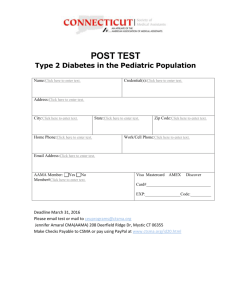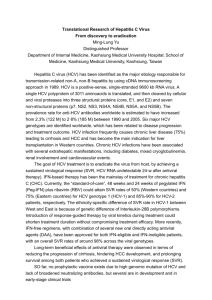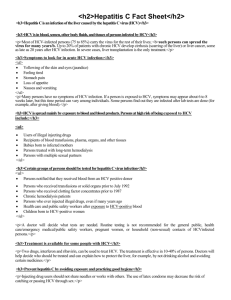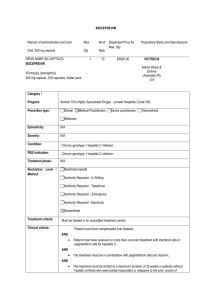What is hepatitis C (HCV)? Pre-test discussion
advertisement
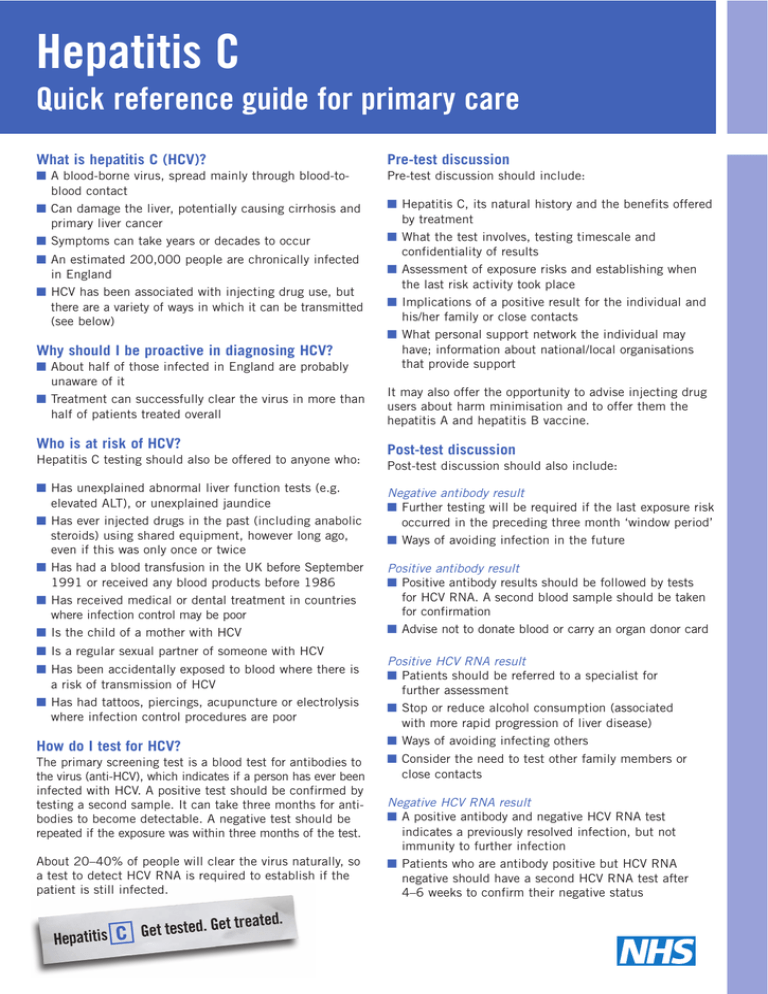
Hepatitis C Quick reference guide for primary care What is hepatitis C (HCV)? Pre-test discussion ■ A blood-borne virus, spread mainly through blood-toblood contact ■ Can damage the liver, potentially causing cirrhosis and primary liver cancer ■ Symptoms can take years or decades to occur Pre-test discussion should include: ■ An estimated 200,000 people are chronically infected in England ■ HCV has been associated with injecting drug use, but there are a variety of ways in which it can be transmitted (see below) Why should I be proactive in diagnosing HCV? ■ About half of those infected in England are probably unaware of it ■ Treatment can successfully clear the virus in more than half of patients treated overall Who is at risk of HCV? Hepatitis C testing should also be offered to anyone who: ■ Has unexplained abnormal liver function tests (e.g. elevated ALT), or unexplained jaundice ■ Has ever injected drugs in the past (including anabolic steroids) using shared equipment, however long ago, even if this was only once or twice ■ Has had a blood transfusion in the UK before September 1991 or received any blood products before 1986 ■ Has received medical or dental treatment in countries where infection control may be poor ■ Is the child of a mother with HCV ■ Is a regular sexual partner of someone with HCV ■ Has been accidentally exposed to blood where there is a risk of transmission of HCV ■ Has had tattoos, piercings, acupuncture or electrolysis where infection control procedures are poor How do I test for HCV? The primary screening test is a blood test for antibodies to the virus (anti-HCV), which indicates if a person has ever been infected with HCV. A positive test should be confirmed by testing a second sample. It can take three months for antibodies to become detectable. A negative test should be repeated if the exposure was within three months of the test. About 20–40% of people will clear the virus naturally, so a test to detect HCV RNA is required to establish if the patient is still infected. ■ Hepatitis C, its natural history and the benefits offered by treatment ■ What the test involves, testing timescale and confidentiality of results ■ Assessment of exposure risks and establishing when the last risk activity took place ■ Implications of a positive result for the individual and his/her family or close contacts ■ What personal support network the individual may have; information about national/local organisations that provide support It may also offer the opportunity to advise injecting drug users about harm minimisation and to offer them the hepatitis A and hepatitis B vaccine. Post-test discussion Post-test discussion should also include: Negative antibody result ■ Further testing will be required if the last exposure risk occurred in the preceding three month ‘window period’ ■ Ways of avoiding infection in the future Positive antibody result ■ Positive antibody results should be followed by tests for HCV RNA. A second blood sample should be taken for confirmation ■ Advise not to donate blood or carry an organ donor card Positive HCV RNA result ■ Patients should be referred to a specialist for further assessment ■ Stop or reduce alcohol consumption (associated with more rapid progression of liver disease) ■ Ways of avoiding infecting others ■ Consider the need to test other family members or close contacts Negative HCV RNA result ■ A positive antibody and negative HCV RNA test indicates a previously resolved infection, but not immunity to further infection ■ Patients who are antibody positive but HCV RNA negative should have a second HCV RNA test after 4–6 weeks to confirm their negative status Hepatitis C What you need to know Treatment for HCV The National Institute for Health and Clinical Excellence (NICE) recommends treatment of chronic hepatitis C with combined pegylated interferon and ribavirin, which can successfully clear the virus in up to 55% of patients overall. Current injecting drug users and people who drink excess alcohol are not precluded from treatment. Since the recent NICE recommendations, liver biopsy need no longer be routine in assessing patients for treatment, though it may be advised for some patients. Treatment may have side effects but these can be satisfactorily managed in most cases. Treatment may be contraindicated for some medical and psychiatric conditions. From diagnosis to treatment – flow chart Unexplained abnormal liver function tests or unexplained jaundice Identify risk factor(s) Pre-test discussion HCV antibody test Test positive HCV RNA test and send repeat sample for confirmation Referral to a hepatitis C specialist Test positive Test negative Post-test discussion Repeat HCV RNA test on a second sample for confirmation Test positive Test negative Repeat antibody test, if in window period Post-test discussion, if not in window period Further tests Treatment (subject to no contraindications) Test negative Post-test discussion Further information ■ NHS hepatitis C awareness website: www.nhs.uk/hepc ■ Hepatitis C Information Line: 0800 451 451 If you require further copies of this title call 0300 123 1002 or visit www.orderline.dh.gov.uk and quote: 292688/Hepatitis C: Quick reference guide for primary care.

